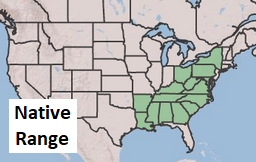Bigleaf Magnolia
Magnolia macrophylla
Click here to download a PDF of this plant information page (for printing).

Sun Exposure: Full Sun, Part Sun
Season of Interest: Spring, Summer, Fall
Bloom Time: Apri - May
Bloom Color: White
Height: 30 to 40 ft.
Spread: 15 to 20 ft.
Spacing: 20 ft.
Water Needs: Average
Maintenance: Very little
Soil Type: Loam, High in organic matter
Soil pH: Acidic, Neutral
Soil Drainage: Well drained
Pests: None
Diseases: None
Wildlife: Bees, Butterflies, Hummingbirds, Birds

Description:
The bigleaf magnolia is a stunning addition to the landscape. The oblong to obovate leaves on this magnolia tree can measure up to 40 inches long and 14 inches wide, hence the species name of macrophylla, which is Latin for "large leaves". The leaves are the largest simple leaf of any North American plant. They are medium green on top and a silvery color on their undersides. The tree bears fragrant white flowers that are equally impressive and massive, with a span of roughly 8 to 12 inches. Even the elongated red fruits that follow the flowers offer visual interest. The fruits also are popular with birds and other wildlife. The tree has a moderate growth rate, gaining around a foot per year and forming a pyramidal shape. For more information see:
plants.ces.ncsu.edu/plants/magnolia-macrophylla
Care and Growing Tips:
Bigleaf magnolias are easy to care for when grown in the right conditions. They do not suffer from any serious pest or disease issues, nor do they require regular pruning to maintain their shape. If you do need to prune to remove a misshapen branch, try to do so in the late winter or early spring. This will prevent the sap from bleeding. Remove any dead, damaged, or diseased branches as they arise.
Bigleaf magnolia trees need a site that has full sun to part shade. Two to five hours of direct sunlight each day is typically sufficient. These trees prefer conditions that mimic their native woodland habitat. Loamy soil that is high in organic matter and drains well is ideal. And a slightly acidic to neutral soil pH is best. Bigleaf magnolias don't do well in soggy or bone dry soil. Always allow the soil to dry out somewhat between waterings, but never allow it to stay dry for too long. Water when the top inch of soil is dry to the touch. Bigleaf magnolias grown in exceptionally well-draining soil will need more frequent watering than trees grown in slow-draining soil types.
The bigleaf magnolia tolerates the temperature highs and lows of the Southeast very well. Humidity also typically is not an issue as long as the tree's moisture requirements are met. A layer of mulch around the tree can help to keep the roots cool and retain soil moisture. One specific climate requirement of bigleaf magnolia trees is a location that does not experience strong winds. Because the leaves of this tree are so large, they are easily damaged by wind gusts. When grown in organically rich soil, bigleaf magnolias often don't need supplemental fertilizer. Signs that fertilizer is necessary include weak new growth in the spring and significant dieback. Use a slow-release fertilizer with a balanced formulation, and apply it during late spring or early summer.